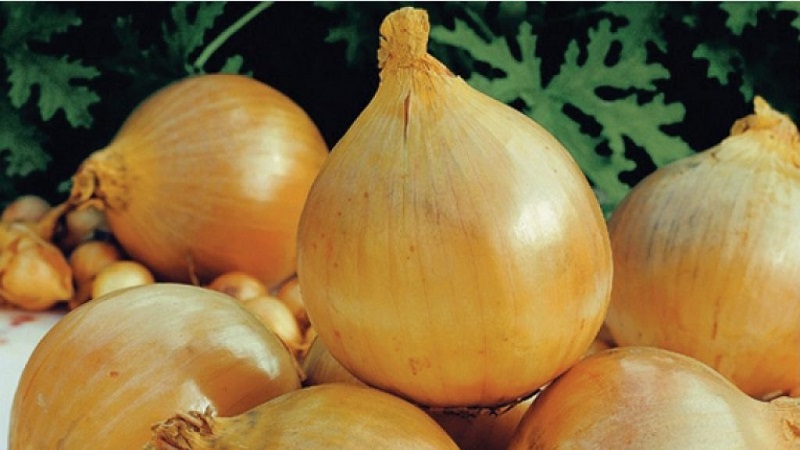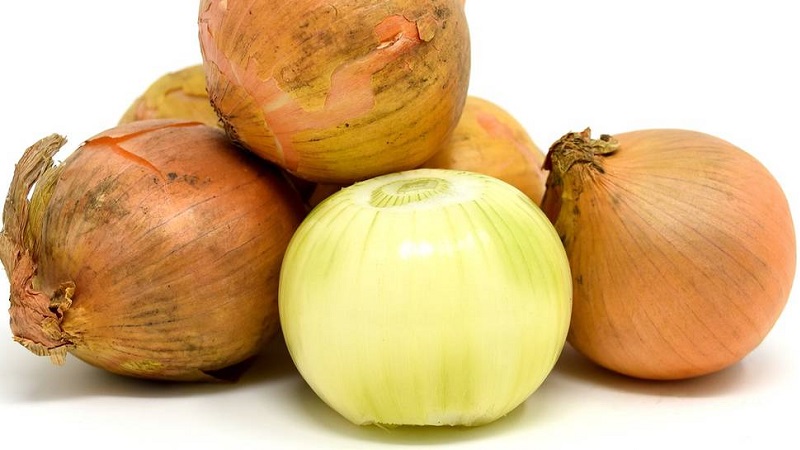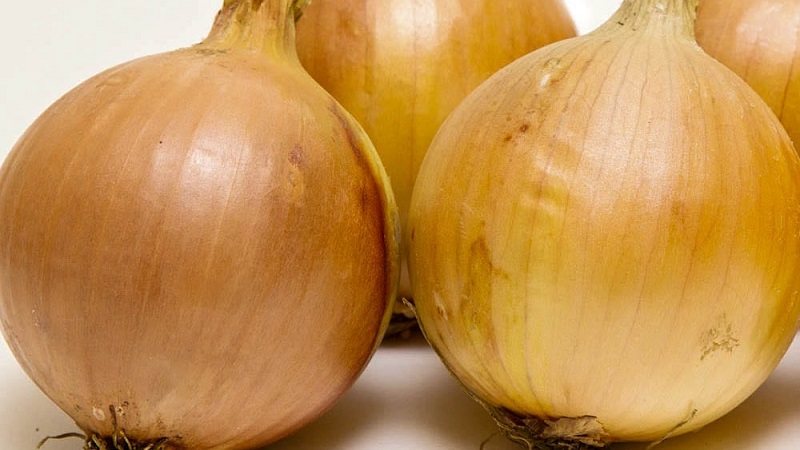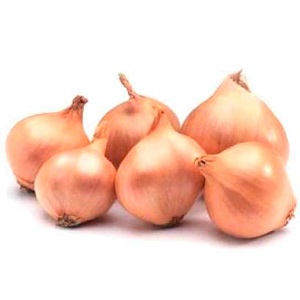Early maturing, frost-resistant winter onion variety "Shakespeare"
For an early harvest, onions are planted before winter. The Shakespeare winter variety is well suited for this purpose, as it is resistant to shooting and tolerates frost well. Planting is carried out in the fall, observing all agrotechnical techniques and recommendations of experienced gardeners.
The content of the article
Description of the variety
Shakespeare belongs to winter varieties of onions and is recommended for growing on a turnip in a two-year culture from seedlings. Consider the features of the variety and the rules of its agricultural technology.
Origin and development
Shakespeare variety bred by Dutch breeders.
Originator - ALLIUM AND BRASSICA CENTER WASH ROAD.

Chemical composition, trace elements and vitamins
Onion rich in phytoncides and vitamins... Also contains citric and malic acids, essential oils, sugar.
Nutritional value per 100 g:
- calorie content - 41 kcal;
- proteins - 1.4 g;
- fats - 0.2 g;
- carbohydrates - 8.2 g;
- water - 86 g;
- dietary fiber - 3 g.
Chemical composition per 100 g:
- vitamin C - 10 mg;
- vitamin E - 0.2 mg;
- vitamin - B6 - 0.1 mg;
- vitamin PP - 0.2 mg;
- vitamin B5 - 0.1 mg;
- calcium - 31 mg;
- magnesium - 14 mg;
- potassium - 175 mg;
- phosphorus - 58 mg;
- sulfur - 65 mg;
- iron - 0.8 mg;
- zinc - 0.85 mg;
- iodine - 3 mcg.
Vegetable used not only for culinary purposesas a remedy in the fight against colds or flu.
Ripening period
The variety is early maturing. Harvested in 75 days from the moment of emergence.
Yield
Up to 3.5 kg of onions can be harvested from 1 m² of plantings, and from 1 hectare they get 30-35 tons of vegetables.

Disease resistance
The Shakespeare variety is immune to many diseases:
- powdery mildew;
- gray rot;
- rust of onions;
- yellow dwarfism;
- mosaic.
Of the pests, the onion fly is the most dangerous.
Description of the appearance and characteristics of the bulb
Shakespeare's onion possesses the following qualities:
- round shape;
- scales are round, dense, yellow-brown;
- juicy white pulp;
- semi-sharp taste;
- onion weight - 100 g;
The variety is distinguished by the absence of arrows, which increases the yield of the crop.
Landing region
Shakespeare is recommended for growing in Central region of Russia. This includes the Bryansk, Ivanovo, Kaluga, Vladimir, Moscow, Ryazan, Smolensk and Tula regions. However, in practice, the variety is widespread in the Urals and even in Siberia.
The main advantages and disadvantages of the variety
Bow Shakespeare has the following positive qualities:
- early maturity;
- beautiful shape of the bulbs;
- the pulp of the fruit is juicy and dense;
- resistant to frost up to - 18 C °;
- resistance to many diseases;
Among the minuses is noted short shelf life of bulbs - within 6 months. But this applies to all winter varieties.
Features of planting and growing
When growing varieties follow agrotechnical rules and recommendationsto get the results you want.

Preparing for landing
It is best to use sevok for planting Shakespeare.... It is desirable that the bulbs are about 1 cm in diameter.
Attention. Be sure to check each bulb before planting.It should be free of rot, stains and other damage.
The advantage of the variety is that the seed is planted without prior soaking and processing... In addition, trimming the necks of the bulbs is also not required.
When growing onions, it is important to observe crop rotation.... Vegetable will grow better in areas where the following crops used to grow:
- all grains except oats;
- cabbage;
- rape;
- beet;
- tomatoes;
- mustard.
Onion not recommended to plant after garlic, carrots, oats, cucumbers and onions.
Ground requirements
Onion prefers sandy and loamy soils... On too dense (clay) soil, the vegetable does not develop. He is also picky about the acidity of the soil. The culture grows well on neutral or slightly alkaline soil, where the pH level is from 6.4 to 7.9.
Preparing the soil for planting begins with digging and removing all plant debris and weeds. The soil must be nutritious. For this, the land can be fertilized with the following composition:
- potassium salt;
- superphosphate;
- humus.
You can add wood ash to the soil... It is especially good for acidified areas. Clay soils are enriched with sand, and sandy soils with clay.
Choose a dry and sunny place for landingliquid should not accumulate there.

Timing, scheme and landing rules
Sevok is planted in early October, but the seeds for it are planted at the end of August. However, the climatic conditions of planting are of great importance. So, in Siberia, the dates will be shifted to the end of September. And in the southern regions, on the contrary, - in the second half of October. But keep in mind that sevok are planted before frost sets in, about a week before.
Shakespeare variety can be planted either one bulb at a time or in nests of 3-4 in one hole... In this case, the neck of the bulb is deepened by a couple of centimeters. The distance between the rows is 20 cm. And between the pits is not more than 10 cm.
After the onion is planted, cover it with a mixture of humus and peat... And on top, the garden needs to be mulched. Hay or dry leaves are good for this. In regions where winters are warm, additional insulation is not required.
In spring, mulch is removedto let the bed warm up in the sun, and the bulbs to start sprouting.
Growing features
Variety Shakespeare is suitable for outdoor seeding... The earth is preliminarily loosened or dug up - it depends on the type of soil. 10-14 days before planting, the bed is sprinkled with wood ash and mixed with a flat cutter.
Important! The crop should not be planted in a lowland, otherwise the planting may be flooded with melt water.
During cultivation, use nitrogen fertilizers strictly according to the instructions.... They are able to provoke the growth of green mass, while the bulbs themselves will not develop.
The nuances of care
When growing onions Shakespeare it is important to follow the basic rules of care: watering, weeding and fertilizing.
Watering mode
After planting, you do not need to water the vegetable... There is sufficient rainfall in the spring. The soil is always wet at this time of the year. Therefore, the first watering is carried out no earlier than in the first half of May.
You need to water once every 8-10 days., spending 1 sq. m 10-12 liters of water. From the beginning to the middle of July, the water consumption is reduced to 8 liters, and from the middle to the end of July, 4-5 liters are watered. The frequency remains the same.
Three weeks before ripening watering the bulbs stop.
Important! Water in the early morning or evening. Water is poured next to the plantings, trying not to get on the bulbs themselves, in order to avoid burns and diseases.
Drying out of the soil is unacceptable, but excess moisture is also not needed.
Loosening the soil and weeding
Be sure to loosen the soil after watering... When doing this, remove only the thin top layer of soil, because the bulbs are close to the surface and are easily damaged.
The procedure is repeated 3-6 times per season.... The frequency depends on the aridity of the climate and the formation of a crust in the garden. But once every 3-4 weeks, loosening is necessary.
Weeding of plantings is equally important from weeds.While the onion is small, it is better to weed with your hands. When you grow up, you can use a hoe. Weed as soon as weeds appear.
Top dressing
The first time fertilization is applied two weeks after germination. To do this, take 60 g of the drug "Ideal", 60 g of urea and 10 liters of water. All ingredients are mixed and brought into the soil where the onion grows.
The second time the procedure is carried out two weeks after the first time. Potassium phosphate preparations would be a good option. Dilute 30 g of superphosphate and 30 g of potassium sulfate in 10 l of water and water the plantings with the resulting solution.
Third feeding done a month before harvest. Dry mineral mixtures are suitable here. They need to be applied after rain or watering.
Disease and pest control
Variety disease resistant... However in order to prevent brown spot, powdery mildew and downy mildew it is recommended use copper oxychloride. To do this, take 30 g of the drug in 10 liters of water. Plantings are watered at the rate of 1 liter of liquid per 10 square meters. m plot.
Important! When growing onions on a feather or set, you cannot use pesticides. But you can treat the planting with wood ash.
Among the pests, the vegetable attacks onion fly... To get rid of it, tobacco dust is sprayed over the area. You can also plant marigolds or calendula next to the garden bed. They protect the plantings well from this pest.
Drugs showed good results "Agrovertin" or "Fitoverm". They are used strictly according to the instructions.
Harvesting and storage
Let's talk about the rules of harvesting. Only fully ripe bulbs can be used for storage.
How and when to collect
Harvesting onions occurs approximately 2.5 months after germination... Yellowed feathers become a signal for action. It is better to choose a dry and windy day. Ripe bulbs are poured in with a pitchfork and lightly shaken off the ground.
Then onions are laid out directly on the beds to dry... After a couple of hours, it is transferred under a canopy, where it must dry completely. This takes about two weeks. During this period, roots and stem residues are removed.
Storage features and keeping quality of the variety
For long-term storage, the vegetable is placed in a cool room.such as a cellar or basement. The temperature there should be 0 ... -1 C °, humidity - 75-90%. When stored in an apartment, the temperature is kept within +18 .. + 22 ° С, and the humidity is at 70%. But the main thing is that the place is well dried, without rot and mold.
Shakespeare stored up to 6 months subject to compliance all conditions.
Growing difficulties
When cultivating a variety, you may encounter with some problems:
- the need to monitor the moisture content of the soil;
- attack of onion midges.
It is important to remove weeds on timeas they carry disease and deprive the plant of nutrients.
Tips from experienced gardeners
Some summer residents advise cover the beds with onions for the winter right before the onset of severe frosts... If you cover the plantings before the onset of stable frosts, then the culture can poorly endure wintering.
On a note. Feeding onions with yeast. Take 500 g of bread crumb and pour 10 liters of warm water over it, then add 500 g of green grass and 500 g of yeast. Leave the solution for 48 hours. After that, you can water the plants.
Reviews of the variety Shakespeare
In general, reviews about Bow Shakespeare are positive... After all, this is one of the few non-shooting varieties. And many summer residents note its delicate taste and aroma.
 Igor, Baimak: “Every year I plant a Shakespeare winter variety and have a great harvest of delicious onions. He has no shooters, which is very pleasing. Of the fertilizers, I only use wood ash and humus. ".
Igor, Baimak: “Every year I plant a Shakespeare winter variety and have a great harvest of delicious onions. He has no shooters, which is very pleasing. Of the fertilizers, I only use wood ash and humus. ".
Tamara, Taganrog: “Shakespeare is very convenient to plant before winter. I start watering only in May or June. The harvest is always plentiful. The bulbs themselves grow even and beautiful ".
Lyudmila, Baimak: “I learned about the variety recently, but it became a favorite on my site. I plant in the fall, and in the spring I already have a garden with seedlings flaunting.But do not forget to fertilize on time. I use mullein infusion for feeding ".
Conclusion
The Shakespeare winter variety is intended for planting before winter and is considered one of the most frost-resistant. This bow attracted the attention of summer residents and the lack of arrows. Subject to all the rules, he will certainly please with a large harvest.